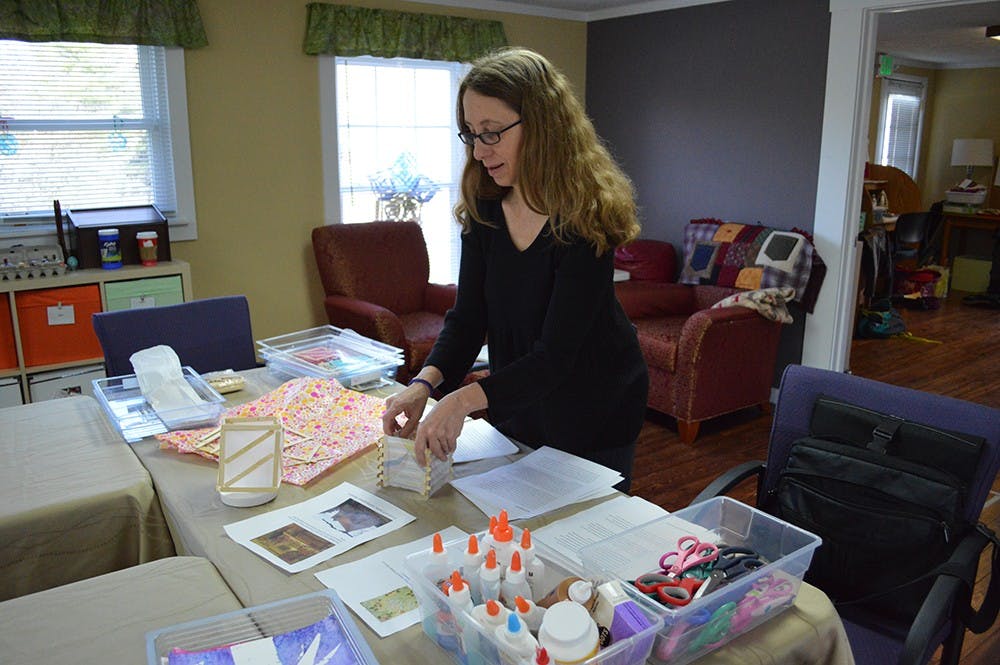She said she gives one handout to each participant to remind them of the steps, listed numerically on the sheet, in case they forget. Doing a sequence project can be difficult for participants with short-term memory loss, she said.
Worley is an art therapist at the Better Day Club, an adult day center in Bloomington designed for individuals suffering from cognitive changes due to aging or Alzheimer’s, as well as other forms of dementia.
In her four years of experience as an art therapist, Worley has worked with many people who have experienced trauma, were diagnosed with cancer or are elderly individuals with cognitive disorders.
With Worley’s recent work at the Better Day Club, she said she discovered art therapy helps the participants in multiple ways.
This kind of therapy helps individuals cognitively, increases their verbalization skills, helps their self-esteem, reduces their anxiety and improves her ability to communicate with their caregivers for both themselves and their caretakers, Worley said.
For elderly patients suffering from Alzheimer’s or other forms of dementia, she said art therapy is an effective method that allows them to acquire new techniques and focus on the abilities they still have.
“We’re using their assets and their strengths instead of focusing on what they can’t do and focusing on something they can do, which is empowering for them,” Worley said.
Dementia directly affects individuals’ mental ability, causing memory loss or difficulty doing everyday tasks, according to the Alzheimer’s Association website.
Because the visual and artistic abilities of those suffering from the disease are not altered until later stages, an individual is able to enjoy the visual aspect of art therapy, said Juliet King, director of art therapy at the Herron School of Art & Design.
“What we are learning about the dementias, including Alzheimer’s, is that imagination is one of the last things to go,” King said. “It seems like there is a cognitive progression, or a regression rather, and patients that have these kinds of challenges seem to hang onto their imaginative or potentials. And these potentials rest in likely different areas and more deeper areas of the brain and this is the area that the creative arts therapies are identified to address.”
Worley said art therapy is important for individuals suffering from cognitive disorders because without it they would not get the physical activity and human interaction they need.
“Those individuals, if they don’t get any therapy, their worlds become smaller and smaller and smaller,” she said. “They tend to isolate and just sit around and not do very much. They need assistance in remaining active, and art therapy is a great way to do that. With some accommodations they can learn new skills and they can flourish.”
Indiana Art Therapy Association President Jessica Buescher said art therapy has a strong influence on individuals with a variety of therapeutic needs because of its use throughout the medical and community health field.
“Art therapy can be used with any population,” she said. “I have worked with a range of children to adults with various conditions and in various settings. As long as the art therapy directive and medium meets the individual where they are in the moment, art therapy can be an effective form of treatment for anyone.”
Art serves as an effective therapeutic method for several individuals because it causes relaxation and allows participants to relieve stress, King said. The process of art therapy is meant to be a soothing and calming experience for the participants, one that causes them to gain a new perspective on what they are doing or on their life.
“The more you’re involved in art, with the support of a therapist, the more you’re able to relax,” she said.
Although art therapy requires creativity, it does not require artistic talent. Participants only need to put forth the effort in order for the treatment to have an effect, Worley said.
“Art therapy is about the process and not about talent,” she said. “It’s more about the process and the creative exploration and play and expression.”






